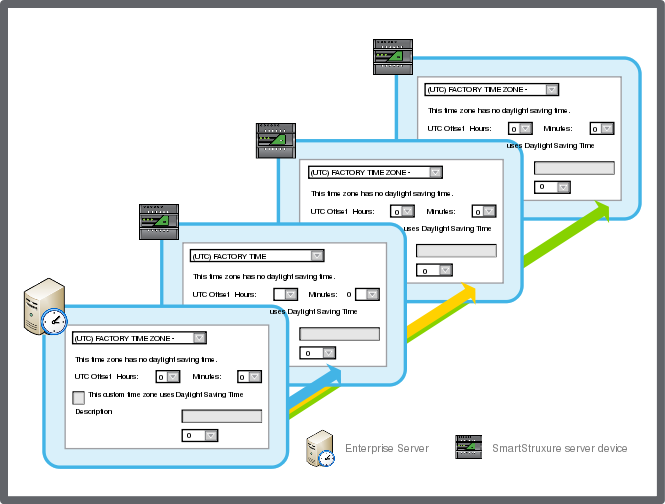
Concepto
Lead and Shadow Relationship
For some objects on the SmartStruxure server device, for example the time zone object and schedule object, you can establish a lead and shadow relationship. You can also establish lead and shadow relationships between graphic elements. A shadow object automatically synchronizes settings from its connected lead object. A lead and shadow relationship can only be established between objects of the same kind.
For example, an Enterprise Server and three individual Automation Servers are located in same time zone region. Instead of individually configuring all the servers time zone, a lead and shadow relationship is established. The Enterprise Server is the lead object and the three Automation Servers are shadow objects. With this relationship, the Enterprise Server time zone settings are reflected and used by the three Automation Servers.

When you set up a lead and shadow relationship, you define which object is the lead object in the properties of the shadow object. For example, to synchronize an Automation Server object with an Enterprise Server object, you define the lead object, in this case the Enterprise Server object, in the properties of the Automation Server.
A server on a higher level, such as an Enterprise Server, typically acts as the lead. However, a lead and shadow relationship can be established between two SmartStruxure server devices.
Synchronize Network Time Settings
You can establish a lead and shadow relationship to synchronize the time on all your SmartStruxure server devices with the same network time server. The Date and Time object on the lead server contains the network time server addresses that are inherited by shadow servers.
Para obtener más información, consulte Synchronize Network Time Settings .
Synchronize Time Zone Settings
You can establish a lead and shadow relationship to synchronize the time zone settings on all your SmartStruxure servers. The Time Zone object on the lead server contains the time zone settings that are inherited by shadow servers.
Para obtener más información, consulte Synchronize Time Zone Settings .
Schedule and Calendar Synchronization
When you configure a schedule that controls events in a single part of a building, you might also want the same events to occur in other areas of the building. You can establish a lead and shadow relationship to synchronize the events in schedules and dates in calendars.
Para obtener más información, consulte Schedule and Calendar Synchronization .
 Synchronize Network Time Settings
Synchronize Network Time Settings
 Synchronize Time Zone Settings
Synchronize Time Zone Settings
 Schedule and Calendar Synchronization
Schedule and Calendar Synchronization